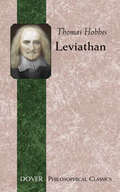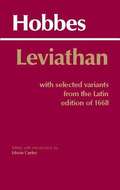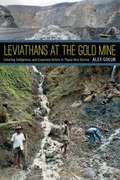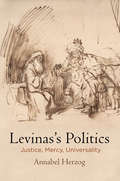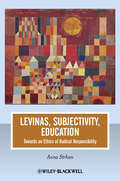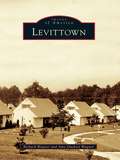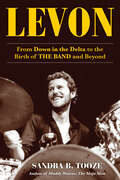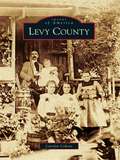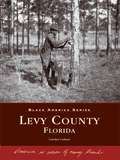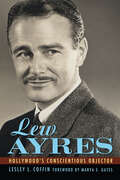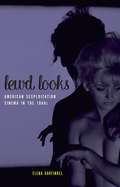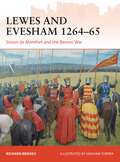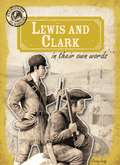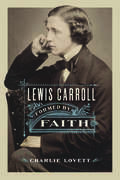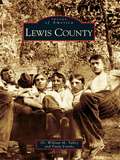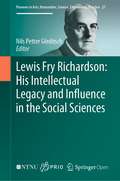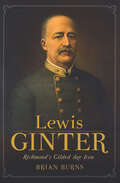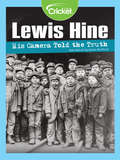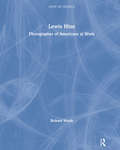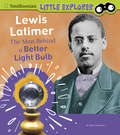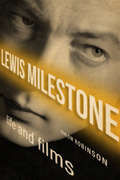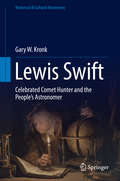- Table View
- List View
Leviathan: The English And Latin Texts (Dover Philosophical Classics)
by Thomas HobbesThomas Hobbes took a new look at the ways in which society should function, and he ended up formulating the concept of political science. His crowning achievement, Leviathan, remains among the greatest works in the history of ideas. Written during a moment in English history when the political and social structures as well as methods of science were in flux and open to interpretation, Leviathan played an essential role in the development of the modern world.An outspoken royalist, Hobbes fled to France during the English civil war, where he wrote this polemic, in which he calls for a powerful sovereign — a "Leviathan" — to act as an enforcer of peace and justice. Hobbes' articulation of this long-contemplated philosophy of political and natural science was finally published in 1651, two years after the overthrow and execution of Charles I. It met with a firestorm of controversy that included charges of treason and sedition. This edition of Hobbes' landmark work is based on the original text. It incorporates the author's own corrections and retains the period spelling and punctuation, offering both flavorful authenticity and the utmost clarity of expression.
Leviathan: The History of Whaling in America
by Eric Jay DolinA Los Angeles Times Best Non-Fiction Book of 2007 A Boston Globe Best Non-Fiction Book of 2007 Amazon.com Editors pick as one of the 10 best history books of 2007 Winner of the 2007 John Lyman Award for U. S. Maritime History, given by the North American Society for Oceanic History "The best history of American whaling to come along in a generation." --Nathaniel Philbrick The epic history of the "iron men in wooden boats" who built an industrial empire through the pursuit of whales. "To produce a mighty book, you must choose a mighty theme," Herman Melville proclaimed, and this absorbing history demonstrates that few things can capture the sheer danger and desperation of men on the deep sea as dramatically as whaling. Eric Jay Dolin begins his vivid narrative with Captain John Smith's botched whaling expedition to the New World in 1614. He then chronicles the rise of a burgeoning industry--from its brutal struggles during the Revolutionary period to its golden age in the mid-1800s when a fleet of more than 700 ships hunted the seas and American whale oil lit the world, to its decline as the twentieth century dawned. This sweeping social and economic history provides rich and often fantastic accounts of the men themselves, who mutinied, murdered, rioted, deserted, drank, scrimshawed, and recorded their experiences in journals and memoirs. Containing a wealth of naturalistic detail on whales, Leviathan is the most original and stirring history of American whaling in many decades.
Leviathan: With Selected Variants From The Latin Edition Of 1668
by Thomas Hobbes Edwin M. CurleyDesigned to meet the needs of both student and scholar, this edition of Leviathan offers a brilliant introduction by Edwin Curley, modernized spelling and punctuation of the text, and the inclusion, along with historical and interpretive notes, of the most significant variants between the English version of 1651 and the Latin version of 1668. A glossary of seventeenth-century English terms, and indexes of persons, subjects, and scriptural passages help make this the most thoughtfully conceived edition of Leviathan available.
Leviathans at the Gold Mine: Creating Indigenous and Corporate Actors in Papua New Guinea
by Alex GolubLeviathans at the Gold Mine is an ethnographic account of the relationship between the Ipili, an indigenous group in Papua New Guinea, and the large international gold mine operating on their land. It was not until 1939 that Australian territorial patrols reached the Ipili. By 1990, the third largest gold mine on the planet was operating in their valley. Alex Golub examines how "the mine" and "the Ipili" were brought into being in relation to one another, and how certain individuals were authorized to speak for the mine and others to speak for the Ipili. Considering the relative success of the Ipili in their negotiations with a multinational corporation, Golub argues that a unique conjuncture of personal relationships and political circumstances created a propitious moment during which the dynamic and fluid nature of Ipili culture could be used to full advantage. As that moment faded away, social problems in the valley increased. The Ipili now struggle with the extreme social dislocation brought about by the massive influx of migrants and money into their valley.
Levinas's Politics: Justice, Mercy, Universality (Haney Foundation Series)
by Annabel HerzogEmmanuel Levinas (1906-1995) was a French philosopher known for his radical ethics and for his contribution to Jewish thought in his commentaries on Talmudic sources. In Levinas's Politics, Annabel Herzog confronts a major difficulty in Levinas's philosophy: the relationship between ethics and politics. Levinas's ethics describes the encounter with the other, that is, with any other human being. For Levinas, the face-to-face encounter is a relationship in which the ego is commanded by a transcendent and unquestionable order to take responsibility for the other person. Politics, on the other hand, presupposes at least three people: the ego, the other, and any third party. Among three people, nothing can be transcendent; on the contrary, everything must be negotiated.Against the conventional view of Levinas's conception of the political as the interruption and collapse of the ethical, Herzog argues that in the Talmudic readings, Levinas constructed politics positively. She shows that Levinas's Talmudic readings embody a pragmatism that complements, revises, and challenges the extreme ethical analyses he offers in his phenomenological works—Totality and Infinity, Otherwise than Being, and Of God Who Comes to Mind. Her analysis illuminates Levinas's explanations of the relationship between ethics and politics: ethics is the foundation of justice; justice contains a necessary violence that must be moderated by mercy; and justice, general laws, and national aspirations must be linked in an attempt to "improve universality itself."
Levinas, Subjectivity, Education: Towards an Ethics of Radical Responsibility (Journal of Philosophy of Education)
by Anna StrhanLevinas, Subjectivity, Education explores how the philosophical writings of Emmanuel Levinas lead us to reassess education and reveals the possibilities of a radical new understanding of ethical and political responsibility. Presents an original theoretical interpretation of Emmanuel Levinas that outlines the political significance of his work for contemporary debates on education Offers a clear analysis of Levinas’s central philosophical concepts, including the place of religion in his work, demonstrating their relevance for educational theorists Examines Alain Badiou’s critique of Levinas’s work Considers the practical implications of Levinas’ theories for concrete educational practices and frameworks
Levittown (Images of America)
by Richard Wagner Amy Duckett WagnerIn 1951, Levittown was created in Bucks County outside of Philadelphia by builder pioneers Levitt and Sons. Dubbed the largest and "most perfectly planned" community in America, it featured single-family homes, schools, churches, shopping centers, and swimming pools. A symbol of the "American Dream," Levittown defined the phenomenon of post-World War II suburban developments, which for the first time gave working- and middle-class families the option of affordable, detached houses outside congested urban neighborhoods. Levittown was a melting pot, attracting people from cities, rural areas, and all walks of life, including many World War II veterans with young families. Houses came fully equipped with appliances and landscaping and started at $9,000. Levittown's superb collection of history and photographs illustrates the birth and growth of this unique area, explores the community that resulted, and features residents' personal memories of the golden years.
Levon: From Down in the Delta to the Birth of THE BAND and Beyond
by Sandra B. ToozeThe life of the legendary drummer and singer is explored through extensive research and personal interviews with family, friends, and fellow musicians.In the Arkansas Delta, a young Levon Helm witnessed &“blues, country, and gospel hit in a head-on collision,&” as he put it. The result was rock 'n' roll. As a teenager, he joined the raucous Ronnie Hawkins and the Hawks, then helped merge a hard-driving electric sound with Bob Dylan's folk roots, and revolutionized American rock with the Band. Helm not only provided perfect &“in the pocket&” rhythm and unforgettable vocals, he was the soul of The Band.Levon traces a rebellious life on the road, from being booed with Bob Dylan to the creative cauldron of Big Pink, the Woodstock Festival, world tours, The Last Waltz, and beyond with the man Dylan called &“one of the last true great spirits of my or any other generation.&” Author Sandra B. Tooze digs deep into what Helm saw as a devastating betrayal by his closest friend, Band guitarist Robbie Robertson—and Levon&’s career collapse, his near bankruptcy, and the loss of his voice due to throat cancer in 1997. Yet Helm found success in an acting career that included roles in Coal Miner&’s Daughter and The Right Stuff. Regaining his singing voice, he made his last decade a triumph, opening his barn to the Midnight Rambles and earning three Grammys.
Levy County
by Carolyn CohensLevy County was founded in 1845 and was named after Florida's first senator, David Levy Yulee. Levy County is a visitor's paradise with the small island of Cedar Key's romantic charm, shops, restaurants, festivals, and art galleries, as well as Chiefland's Train Depot Museum, Suwannee Valley Theater, Watermelon Festival, Christmas Parade of Lights, and Williston Peanut Festival. The woods of Levy County are a sportsman's paradise for hunting and fishing, and divers come from near and far to explore and enjoy the underwater caves of Manatee Springs Park.
Levy County, Florida (Black America Series)
by Carolyn CohensDriving along Levy County highways, one can always see crops of corn, watermelons, peanuts, cantaloupes, and vegetables. The county contains the cities of Cedar Key, noted for its romantic atmosphere and annual seafood and art festivals; Chiefland, a small town with a friendly atmosphere; and Rosewood, noted today for its tours and markers dedicated to those who tragically lost their lives.
Lew Ayres: Hollywood's Conscientious Objector (Hollywood Legends Series)
by Lesley L. CoffinLew Ayres (1908-1996) became known to the public when he portrayed the leading character in the epic war film All Quiet on the Western Front. The role made him a household name, introduced him to his closest friends, brought him to the attention of his first two wives, and would overshadow the rest of his career. To be a movie star was his first and only ambition as a child, but once he found success, he was never fully satisfied in his choice of profession. Although lacking a formal education, Ayres spent the rest of his life pursuing dozens of intellectual studies, interests, and hobbies. He even considered ended his acting career after just a few years to pursue a more “respectable and fulfilling” path as a director. Ayres was given not one but two comeback opportunities in his acting career, in 1938 and 1945. He was cast in the film series Dr. Kildare where he showed his abilities in comedy and his unique strength at bringing a level of sincerity to even the most outlandish or idealist character. But he was willing to give up his star status to follow his moral compass, first as a conscientious objector and ultimately as a noncombat medic during World War II. To everyone’s surprise, he was welcomed back to Hollywood with open arms and new opportunities despite his objector status. Biographer Lesley L. Coffin presents the story of a man of quiet dignity, constantly searching for the right way to live his life and torn between the public world of Hollywood and secluded life of spiritual introspection.
Lewd Looks: American Sexploitation Cinema in the 1960s
by Elena GorfinkelOne of the most fascinating phenomena of 1960s film culture is the emergence of American sexploitation films—salacious indies made on the margins of Hollywood. Hundreds of such films were produced and shown on both urban and small-town screens over the course of the decade. Yet despite their vital importance to the film scene, and though they are now understood as a gateway to the emergence of publicly exhibited hardcore pornography in the early 1970s, these films have been largely overlooked by scholars.Defined by low budgets, quick production times, unknown actors, strategic uses of nudity, and a sensationalist obsession with unbridled female sexuality, sexploitation films provide a unique window into a tumultuous period in American culture and sexual politics. In Lewd Looks, Elena Gorfinkel examines the social and legal developments that made sexploitation films possible: their aesthetics, their regulation, and their audiences. Gorfinkel explores the ways sexploitation films changed how spectators encountered and made sense of the sexualized body and set the stage for the adult film industry of today. Lewd Looks recovers a lost chapter in the history of independent cinema and American culture—a subject that will engross readers interested in media, sexuality, gender, and the 1960s. Gorfinkel investigates the films and their contexts with scholarly depth and vivid storytelling, producing a new account of the obscene image, screen sex, and adult film and media.
Lewes and Evesham 1264-65
by Richard BrooksAt the crescendo of the Second Barons' War were the battles of Lewes and Evesham. It was an era of high drama and intrigue, as tensions between crown and aristocracy had boiled over and a civil war erupted that would shape the future of English government. In this detailed study, Richard Brooks unravels the remarkable events at the battles of Lewes and Evesham, revealing the unusually tactical nature of the fighting, in sharp contrast to most medieval conflicts which were habitually settled by burning and ravaging. At Lewes, Simon de Montfort, the powerful renegade leader of the Baronial faction, won a vital victory, smashing the Royalist forces and capturing Henry III and Prince Edward. Edward escaped, however, to lead the Royalist armies to a crushing victory just a year later at Evesham. Using full color illustrations, bird's eye views and detailed maps to generate an arresting visual perspective of the fighting, this book tells the full story of the battles of Lewes and Evesham, the only pitched battles to be fought by English armies in the mid-13th century.
Lewis & Clark For Dummies
by Sammye J. Meadows Jana PrewittThe Lewis and Clark expedition was the greatest camping trip in history. It was one of those irresistible American adventures that many people dream of living. This book shares the delightful details of the journey that historians have gleaned from the group's journals and maps, and also discusses what's known of the Indian perspective of the expedition. Throughout the book, you find out about Jefferson's western exploration from his earliest efforts to see the Corps assembled through the aftermath for the explorers, the tribes, and the United States. But the focus of Lewis & Clark For Dummies is on the period between Jefferson's confidential letter to Congress requesting dollars to mount a western exploration (January 18,1803) and the expedition's triumphant (and improbable) return to St. Louis (September 23, 1806): forty-two months that changed the world. Join Lewis and Clark as they recruit the Corps of Discovery, meet Sacagawea and various Indian tribes, and set off along the Missouri River on a thrilling, perilous journey. Lewis & Clark For Dummies also covers the following topics and more: The expedition's people and places Jefferson's fascination with the West Final preparations of Meriwether Lewis Weathering storms to launch the expedition The discomforts and dangers of the journey Making maps and writing reports A first look at the Pacific Ocean The story of Lewis and Clark doesn't end with their return to St. Louis. This book will also lead you on an exploration of the fates and lessons of the Corps of Discovery. Find out what happened to Lewis, Clark, and many other key players after their famous journey. And examine the aftermath for the American Indians and the political and cultural ramifications for the United States. You'll even find the resources you need to plan your own recreation of the expedition as you take the Trail yourself!
Lewis And Clark In Their Own Words
by Janey LevyThe journey of Meriwether Lewis and William Clark across the newly acquired Louisiana Territory from 1804 to 1806 was truly extraordinary. It's best explained using the journals of these two explorers. In this book, primary source materials were carefully chosen to highlight the most interesting and exciting parts of the adventure. An Eyewitness to History book.
Lewis Carroll: Collections and Collectors
by Edward GuilianoThis is the first book on the history and culture of collecting the works of Lewis Carroll as well as the worldwide industry of items and art based on Carroll&’s works in popular culture. Ten large, major private collections from around the world are profiled, telling the story of each collection and collector, with color illustrations of objects from the collections. The volume, which also covers smaller specialized collections and includes a comprehensive introduction to the history and characteristics of collecting Carrolliana, will appeal to Carroll enthusiasts and rare book and memorabilia collectors alike.
Lewis Carroll: Formed by Faith
by Charlie LovettFor Lewis Carroll, a deacon in the Church of England, faith in Christ and belief in a loving God stood at the core of his being, but little has been written about what the church or faith meant to the celebrated author of the Alice books. With Lewis Carroll: Formed by Faith, Charlie Lovett provides the first in-depth study of the religious life of the famous author, whose real name was Charles Lutwidge Dodgson.By examining Dodgson’s religious education and core beliefs, this book shows how a deep Christian faith undergirded and guided every part of his life and work, from his relationships with children to his renowned writings, his work on logic, even his hobbies of photography and theatre going. The book includes a detailed account of the career of Dodgson’s father—an important figure in the Anglican church and a key influence on his son.Family records give insight into Charles’s early education, and newly discovered manuscript materials paint a full picture of his religious education at Richmond and Rugby Schools. Lovett finds previously unknown influences in Dodgson’s life, analyzes his habits of preaching and prayer, explores his training for confirmation and ordination, analyzes his reasons for eschewing the priesthood, and concludes with an account of his death and funeral and his logically constructed theology of the afterlife. The book makes use of previously untapped sources and highlights new material, including a previously unknown sermon by Dodgson, the first ever discovered. The result is a major contribution offering new perspectives on this creator of fantastical fiction and the spiritual bedrock that informed his life and imagination.
Lewis County (Images of America)
by Paula Franke Dr William TalleyLewis County, located in far northeastern Kentucky, was formed in 1806 and named for explorer Meriwether Lewis. The county was once teeming with industry as a supplier of finished goods and agricultural products. Historically, the county's proximity to the Ohio River allowed the export oftimber and salt, and in the 1800s, railroad transportation made Lewis County an influential source of railroad ties, boat-building materials, and barrels. In later years, the area was most popular for its health resorts, spas, and "sulfur waters," which attracted visitors from as far as New York and Chicago. The images in this volume depict the county's military influence, as Lewis Countians had strong allegiance to the Union during the Civil War. The photographs featured in Images of America: Lewis County have been drawn from the archive of the Vanceburg DepotMuseum and from various private collections.
Lewis Fry Richardson: His Intellectual Legacy And Influence In The Social Sciences (Pioneers in Arts, Humanities, Science, Engineering, Practice #27)
by Nils Petter GleditschThis is an open access book. Lewis F Richardson (1981-1953), a physicist by training, was a pioneer in meteorology and peace research and remains a towering presence in both fields. This edited volume reviews his work and assesses its influence in the social sciences, notably his work on arms races and their consequences, mathematical models, the size distribution of wars, and geographical features of conflict. It contains brief bibliographies of his main publications and of articles and books written about Richardson and his work and discusses his continuing influence in peace research and international relations as well as his attitude to the ethical responsibilities of a scientist. It will be of interest to a wide range of scholars. This book includes 11 chapters written by Nils Petter Gleditsch, Dina A Zinnes, Ron Smith, Paul F Diehl, Kelly Kadera, Mark Crescenzi, Michael D Ward, Kristian Skrede Gleditsch, Nils B Weidmann, Jürgen Scheffran, Niall MacKay, Aaron Clauset, Michael Spagat and Stijn van Weezel.Lewis F Richardson occupied an important position in two academic fields as different as meteorology and peace research, with academic prizes awarded in both disciplines.In peace research, he pioneered the use of mathematical models and the meticulous compilation of databases for empirical research.As a quaker and pacifist, he refused to work in preparations for war, paid a heavy prize in terms of his career, and (at least in the social sciences) was fully recognized as a pioneering scholar only posthumously with the publication of two major books.Lewis Fry Richardson is one of the 20th century’s greatest but least appreciated thinkers—a creative physicist, psychologist, meteorologist, applied mathematician, historian, pacifist, statistician, and witty stylist. If you’ve heard of weather prediction, chaos, fractals, cliometrics, peace science, big data, thick tails, or black swans, then you have benefited from Richardson’s prescience in bringing unruly phenomena into the ambit of scientific understanding. Richardson’s ideas continue to be relevant today, and this collection is a superb retrospective on this brilliant and lovable man.Steven Pinker, Johnstone Professor, Harvard University, and the author of The Better Angels of Our Nature and Enlightenment Now
Lewis Ginter: Richmond's Gilded Age Icon
by Brian BurnsA biography of the nineteenth-century influential Richmond businessman.As a Confederate war hero, philanthropist and entrepreneur, Lewis Ginter was many things to Richmond. Performing integral missions for &“Stonewall&” Jackson and Robert E. Lee, Ginter was commended for gallantry on the battlefield and became affectionately known as the &“Fighting Commissary.&” After the war, Ginter was the first major marketer of the hand-rolled cigarette in America. He developed one of America&’s first streetcar suburbs and built the magnificent Jefferson Hotel, a symbol of Richmond&’s ambition and prosperity. But beyond the well-known history of this River City icon, there are many aspects of his personal and professional life that few know about. Join local writer Brian Burns as he delves into the hidden history of Ginter&’s extraordinary life to fill in the gaps between Ginter the man and Ginter the legend.&“By using many original sources, [Burns] writes of details of Ginter's life that even longtime Richmond-history buffs may not know.&” —Richmond Times-Dispatch
Lewis Hine: His Camera Told the Truth
by James RumfordIt was once common for children to work at jobs with little pay. Then a photographer named Lewis Hine urged this dangerous practice stop to with the power of his camera and the assistance of lawmakers. Learn more about the history of child labor in the United States and how it became outlawed.
Lewis Hine: Photographer of Americans at Work (Show Me America (group 1) Ser.)
by Richard WorthLewis Wickes Hines documentary photography helped promote the cause of the National Child Labor Committee, which published there declaration in 1913. This text is a collection of photographs showing children at work from 1910 to 1935 as Hines travelled across America.
Lewis Latimer: The Man Behind a Better Light Bulb (Little Inventor)
by Nancy DickmannWhy is Lewis Latimer important? His invention of the carbon filament made light bulbs more afforable and longer lasting. Readers follow his journey from working with Alexander Graham Bell to improving Thomas Edison's light bulb. It's an enlightening story filled with engaging text and colorful images, all reviewed by Smithsonian experts.
Lewis Milestone: Life and Films (Screen Classics)
by Harlow RobinsonA biography of the Oscar-winning director and a study of his acclaimed films, like All Quiet on the Western Front, The Front Page, and Of Mice and Men. This comprehensive biography is the first to present Lewis Milestone&’s remarkable life—a classic rags-to-riches American narrative—in full and explores his many acclaimed films from the silent to the sound era. Creator of All Quiet on the Western Front, Of Mice and Men, the original Ocean&’s Eleven and Mutiny on the Bounty, Lewis Milestone (1895-1980) was one of the most significant, prolific, and influential directors of our time. A serious artist who believed in film&’s power not only to entertain, but also to convey messages of social importance, Milestone was known as a man of principle in an industry not always known for an abundance of virtue. Born in Ukraine, Milestone came to America as a tough, resourceful Russian-speaking teenager and learned about film by editing footage from the front as a member of the Signal Corps of the US Army during World War I. During the course of his film career, which spanned more than 40 years, Milestone developed intense personal and professional relationships with such major Hollywood figures as Howard Hughes, Kirk Douglas, Marlene Dietrich, and Marlon Brando. Addressed are Milestone&’s successes?he garnered 28 Academy Award nominations?as well as his challenges. Using newly available archival material, this work also examines Milestone&’s experience during the Hollywood Blacklist period, when he was one of the first prominent Hollywood figures to fall under suspicion for his alleged Communist sympathies.Praise for Lewis Milestone&“This highly readable biography of Lewis Milestone delivers the definitive study of a leading Jewish émigré director in Hollywood from the 1920s to the 1960s who worked successfully across multiple genres. Robinson seamlessly layers the scholarly expertise of a noted film historian of Russia and the Soviet Union with a novelist&’s gift for narrative power and dramatic flair, bringing long overdue attention to Milestone&’s fascinating life and enduring artistic achievements.&” —Catherine Portuges, University of Massachusetts Amherst&“A welcome biography of a man whose films remain better known than his name . . . . Robinson concentrates on the key aspects of Milestone&’s life and career, never getting bogged down in plot synopses or other minor issues. Rather than shoveling up endless rubble, he offers us the milestones of Milestone. Robinson&’s story is as tight as most classic Hollywood films, and that deserves to be heralded. This is a book equally as valuable to film buffs as to academic scholars, speaking to readers inside and outside the academy.&” —LA Review of Books
Lewis Swift: Celebrated Comet Hunter and the People's Astronomer (Historical & Cultural Astronomy)
by Gary W. KronkThis biography covers the life of Lewis Swift (1820-1913), who discovered 13 comets and nearly 1,200 other deep sky objects. All 13 comets found by Swift now bear his name, including three periodic comets with periods of 6 years (11P/Tempel-Swift-LINEAR), 9 years (64P/Swift-Gehrels), and 133 years (109P/Swift-Tuttle).Swift's enthusiasm and success as an amateur astronomer helped make him famous in the United States. With the help of others, Swift was able to buy a 16-inch refractor, the third largest telescope in the United States at the time. Hulbert Harrington Warner built "Warner Observatory" to house this telescope. As a prolific writer and lecturer, Swift's stories appeared in newspapers and magazines, while his lectures showed that he was able to explain anything in a way that everyone could understand. When Warner went broke during the "Panic of 1893," Swift was forced to leave his home. Almost two dozen invitations arrived from around the United States asking him to bring his telescope to their city, and he eventually accepted the invitation of Californian Thaddeus Sobieski Constantin Lowe. This book highlights Swift's valuable contributions to astronomy before failing eyesight forced him to give up this profession. In addition to detailing Swift's life, biographical material is also provided for a number of individuals who were influenced by Swift. This includes his son, Edward, who was discovering deep sky objects as a teenager.
